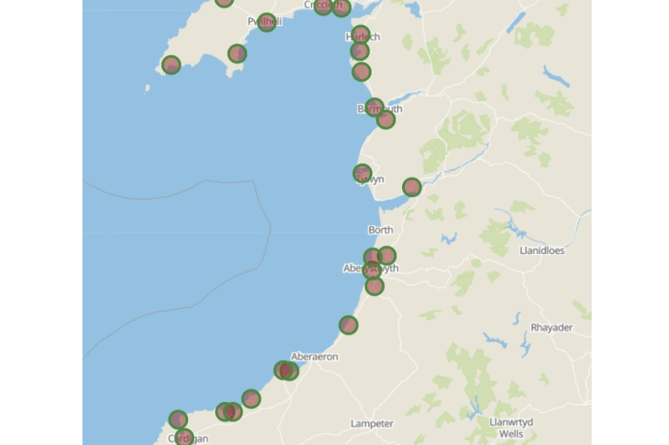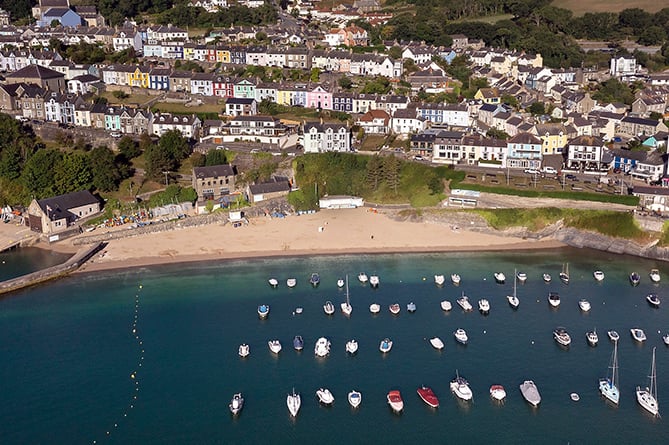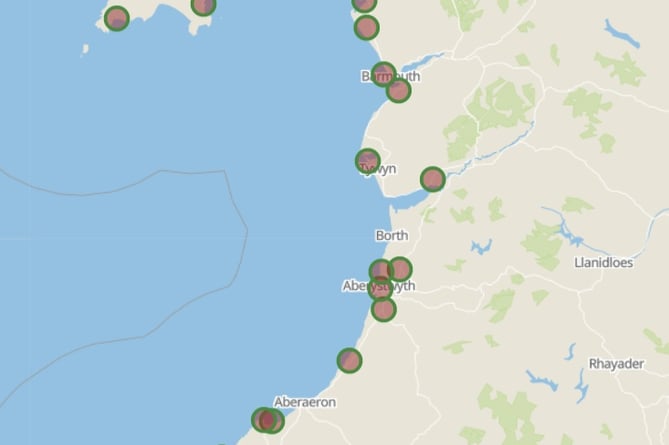New Quay saw the fifth highest level of sewage pollution of any beach in Wales last year - and a new map has revealed on which stretches of Cardigan Bay spills are most common.
Data released last week from the country’s primary water supplier Dŵr Cymru and environmental regulator Natural Resources Wales (NRW) revealed a concerning record of discharges across seas, rivers and waterways in Ceredigion last year.
An analysis of the data estimates the county saw more than 3,800 dumps last year – equating to a total duration of 33,000 hours or about four years of overflow.
This is the ninth highest of any constituency in England and Wales - though the duration of combined discharges has fallen by nearly 6,900 on 2021.
New Quay beach in south Ceredigion saw a dramatic inflation in discharges reaching a duration of 1,800 hours (up nearly 400) from 138 separate incidents during last year, bucking a downward national trend. It saw the fifth most sewage overflow of any beach in Wales.

Aberystwyth South saw 1,500 hours of discharges, down a quarter on the year before, and nearly 200 individual dumps. It saw the ninth longest combined duration of any Welsh beach. Poppit Sands West flowing out from Cardigan saw the same duration of discharge from only 137 separate incidents. Clarach South and Aberporth both saw about 400 hours of overflow.
Some of those that saw the highest levels of sewage pollution were also Blue Flag beaches.
Aberystwyth South, Borth, Llangrannog and Tresaith were all recipients of the prestigious award last year.
But at the awards last May it was also decided New Quay Harbour and Aberystwyth North should be stripped of their status.
Blue Flag recognition is a prestigious international award scheme from the Foundation for Environmental Education charity which aims to provide assurance to bathers that a beach has met a minimum standard of water quality.
Aberystwyth South Beach was first awarded a Blue Flag in 2019 and joined an exclusive group of less than 25 across the country at the time. The status is repealed if water quality standards slip.

When it comes to rivers, the Teifi saw the second longest total duration of discharges of any in the country last year.
There were about 1,900 separate discharges in the Teifi, Wales’ longest river, equating to about 14,000 hours of overflow.
The River Dyfi endured about 320 hours of combined sewage overflow from 56 separate dumps. And the Ystwyth, with its source in the Cambrian Mountains, saw 1,500 hours of spew from about 200 discharges.
Controversy surrounds the practices of the UK’s private water companies which are legally entitled to release sewage to relieve pressure on the system, mostly during periods of extreme weather.
The private water sector refers to such discharges as combined storm overflows (CSOs) and warns of flooding and damage to the system if they are prevented. But opponents say companies have neglected an antiquated network of pipes which increases the need for the divisive practice.
In what the water industry is hailing as a success, rates of storm overflow across all the nation’s providers are down for the second year running. But regulators have quickly confirmed the improvement was almost entirely down to the unprecedentedly dry weather.
The 301,000 discharges in England and Wales (824 per day) represent a 19 per cent fall from 2021 levels.

A Dŵr Cymru spokesperson told the Cambrian News there was a 12 per cent reduction in the average number of releases per storm overflow compared 2021, as well as a 25 per cent reduction in total spill duration in 2022.
The Top of the Poops website includes a clear disclaimer that the interpretation of the data provided for Wales was less straightforward than for English companies, so there is greater room for error.
The website producers confirmed to The Cambrian News following questioning that no correction had ever been requested from Dŵr Cymru.
A spokesperson said: “There was a modest reduction in sewage overflows in 2022, compared to the previous year, however 2022 also saw a lower-than-average rainfall - so really this outcome cannot be linked with any affirmative action by any water company - it is just their luck.
“There is no reason, except in genuinely exceptional circumstances for raw sewage to be poured into our waterways.
“Circumstances like these might occur once every few years, not hundreds of thousands of times a year - in the case of Dwr Cymru.
“It is a diversionary tactic to talk about agricultural run-off. Of course, this should be addressed - it is simply corporate whataboutery, as part of the ‘deny, delay, deflect’ communications strategy.
“We have received no complaint about any of the figures on our site from any water company - we would welcome any feedback regarding their accuracy and would happily amend any data found to be inaccurate.
“Dwr Cymru releases sewage 218 times a day, on average, into Welsh (and some English) waterways.
“Should the chief executive be paid £560,000 for this?”
Llandysul environmental campaigner Robert Winter also criticised not-for-profit Dŵr Cymru over handing out performance-related bonuses of nearly seven-figures to its top three executives over the last two years.
Based on figures from their audited accounts, Peter Perry (chief executive), Mike Davis (chief financial officer) and Chris Jones (executive director) took home bonuses worth £931,000.
Mr Perry earned a basic salary of £332,000 last year and £232,000 in short and long term bonuses.
Ceredigion Liberal Democrat Leader Cllr Elizabeth Evans said: “It is tragic that Ceredigion has some of the most sewage-filled rivers in the entire UK. This issue is placing human health in danger alongside our wildlife and tourism industry.
“The Labour-Plaid Cymru partnership in Cardiff Bay has failed at every step to take this issue seriously.
“Now they expect the taxpayers to pay to clean up their mess while water company executives have spent years siphoning off money to pay themselves large bonuses.
“These large bonuses should be banned, and the money reinvested into improving infrastructure. Dŵr Cymru is meant to be a non-profit.”
A Dŵr Cymru spokesperson said: "With monitors now on over 99.5 per cent of our overflows, we are able to provide one of the most comprehensive reports on how our storm overflows perform.
"We report this information to our environmental regulators and also provide real time spill information for key bathing waters to interested bodies, including Surfers Against Sewage and Rivers Trust.
"While we are pleased to see the reduction, which in part is due to the investment work we are undertaking to reduce spills, the reduction has also been influenced by the weather we saw last year.
"The annual rainfall for the year was 10 per cent below the long term average, we saw the driest January-August period since 1976 and drought conditions were declared across parts of Wales and England.
"The total removal of combined storm overflows from our system is unaffordable and would take decades and therefore is not an option but what is in our control is the ability to target investment to CSOs which have the biggest environmental impact.
"That is why we are investing significantly to improve CSOs with £140m being invested between 2020-2025 and a further £420m planned from 2025 to 2030.
"Our investment to date in our wastewater system has delivered real improvements and helped ensure Wales has over a third of the UKs Blue Flag beaches while only having 15 per cent of the coastline and that 40 per cent of our rivers and waterbodies meet good ecological status compared to 16 per cent in England.
"However, we recognise that with environmental legislation tightening and customer expectations changing, more needs to be done to protect bathing and river water quality.
"Equally as important as tackling CSO’s is tackling phosphorous pollution and we are delivering a comprehensive programme of upgrades to our wastewater treatment works that will remove 90 per cent of our phosphorous discharges by 2030."
An NRW spokesperson said: "In the main, the improvement is due to dry weather and drought conditions in 2022, rather than action by water companies.
"We know that sewer overflows exist and are necessary to prevent flooding of people’s homes with raw sewage.
"Our role is to ensure that permits to discharge, issued by NRW, are complied with by water companies.
"We also ensure that the sewer network is improved to reduce or eliminate spills and to make sure that it is operating as designed and to the latest standards.
"We share the wider public concern and are equally concerned about the impact of storm discharges on our water quality and are calling for action now to prevent storm overflows causing environmental harm.
"This means the right mix of maintenance, management and investment by water companies, alongside action to drive down surface water entering sewers and the public using sewers appropriately.
"NRW is providing evidence on the scale of investment required to inform Ofwat’s review of Water company prices, which plays a key role in determining the scale of action that water companies undertake between 2025 and 2030.
"We have a programme in place with water companies in Wales to investigate and rectify any issue of non-compliance. We assess whether there is an environmental impact from the discharges and require the appropriate investment to deliver improvements to the wastewater infrastructure.
"We want all water companies to meet the expectations of their customers and the needs of our environment. We will continue to challenge the water companies to make sure storm overflows are properly controlled. We will investigate and where appropriate take the required enforcement action."
NRW confirmed to the Cambrian News there are 220 unpermitted overflows from water companies to waterways in Wales. A spokesperson said all of these overflows have monitoring equipment which was installed at NRW's request
"To address this in future, we have put a programme in place to ensure that all unpermitted storm overflows that have been identified in Wales are brought within our regulatory framework, they said.
"In this way we will assess whether there is an environmental impact from the discharges and require the appropriate investment to deliver improvements to the wastewater infrastructure."




